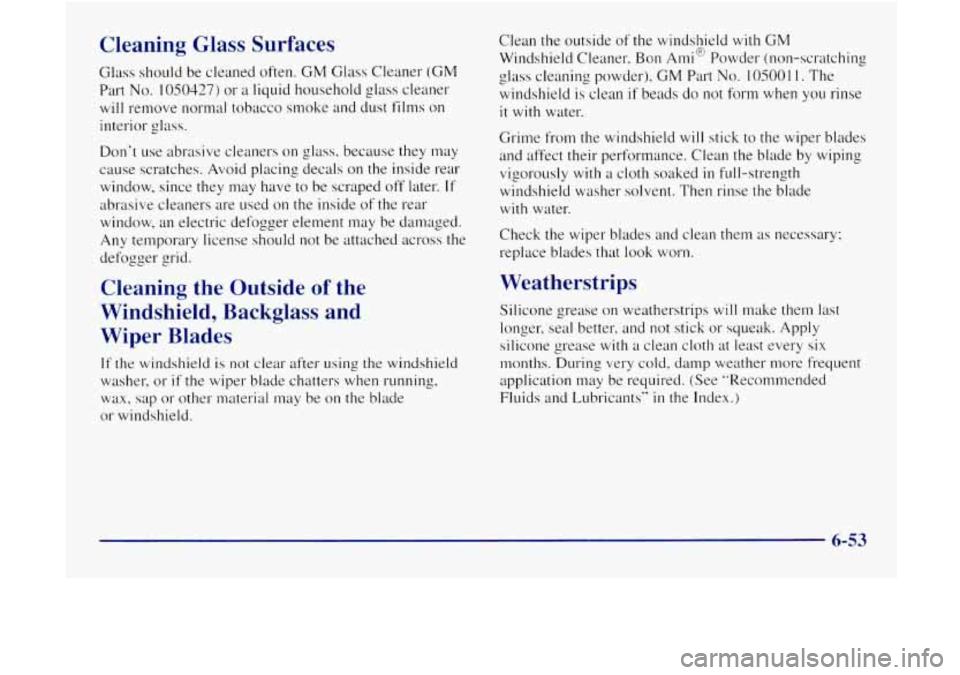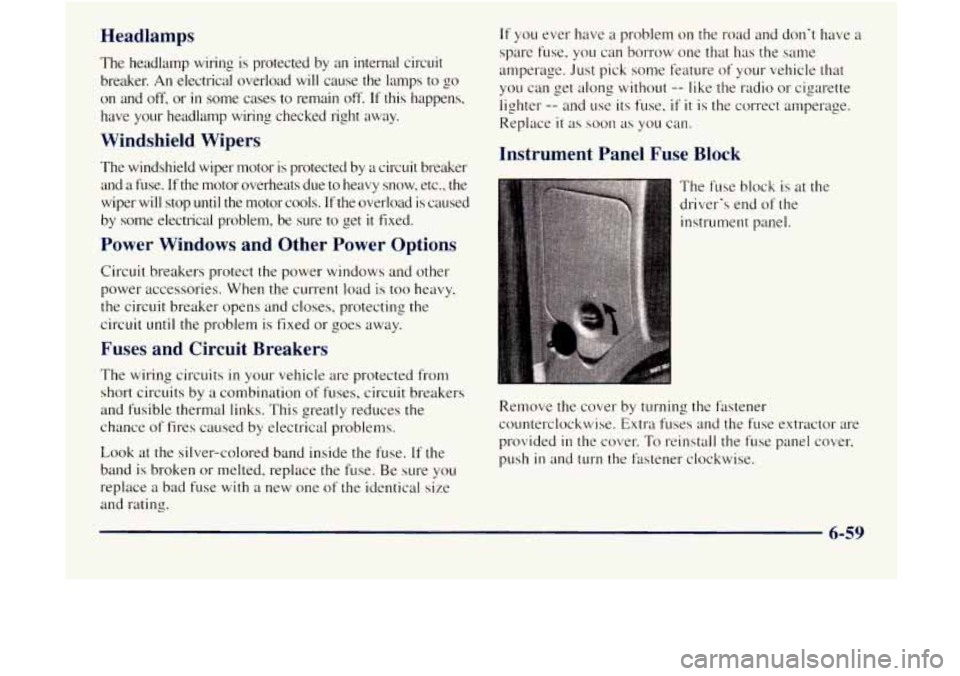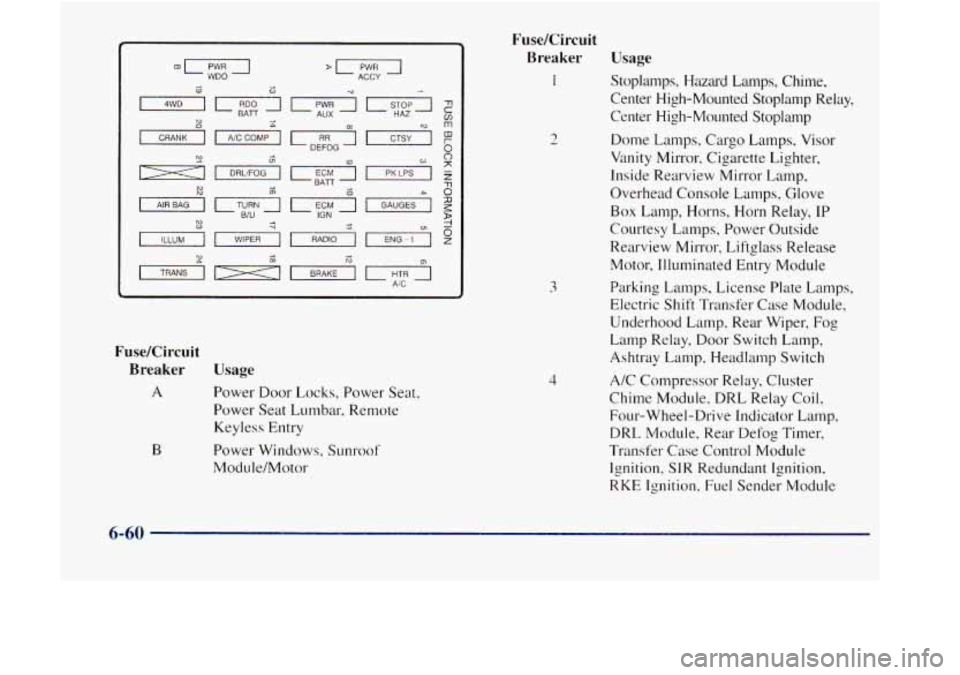GMC JIMMY 1997 Owner's Manual
Manufacturer: GMC, Model Year: 1997, Model line: JIMMY, Model: GMC JIMMY 1997Pages: 410, PDF Size: 20.03 MB
Page 311 of 410

Cleaning Vinyl
Use warm water and a clean cloth.
Rub with a clean, damp cloth to remove dirt. You
may have to do it more than once.
Things like tar, asphalt and shoe polish will stain if you
don't get then1 off quickly.
Use a clean cloth and a
vinyl/leatlm- cleaner. See your dealer for this product.
Cleaning Leather
Use a soft cloth with lukewarm water and a mild soap or
saddle soap and wipe dry with
a soft cloth. Then, let the
leather dry naturally.
Do not me heat to dry.
0 For stubborn stains, use a leather cleaner. See your
dealer for this product.
Nel1L.r use oils. varnishes, solvent-based or Ltbrasive
cleaners, furniture polish or shoe polish on leather.
Soiled or stained leather should be cleaned
immediately.
If dirt is allowed to work into the
finish, it can harm the leather.
Cleaning the Top of the Instrument Panel
Use only mild soap and water to clean the top surfaces
of
the instrument panel. Sprays containing silicones or
waxes may cause annoying retlections
in the windshield
and even make
it difficult to see through the windshield
under certain conditions.
C-are of Safet.y Belts
Keep belts clean and dry.
I
r
Do not bleach or dye safety belts. If you do, it
may severely weaken them. In a crash, they
might not be able
to provide adequate protection.
Clean safety belts only with mild soap and
lukewarm water.
6-52
Page 312 of 410

Cleaning Glass Surfaces
Glass should be cleaned often. GM Glass Cleaner (GM
Part
No. 1050427) or a liquid household glass cleaner
will remove normal tobacco smoke and dust films on
interior glass.
Don't use abrasive cleaners on glass. because they may
cause scratches. Avoid placing decals on
the inside rear
window, since they may have to be scraped off later.
If
abrasive cleaners are used on the inside of the rear
window, an electric defogger element may be damaged.
Any temporary license should not be attached across the
defogger grid.
Cleaning the Outside of the
Windshield, Backglass and
Wiper Blades
If the windshield is not clear after using the windshield
washer, or
if the wiper blade chatters when running.
wax, sap or other material may be on the blade
or windshield. Clean the outside
of the windshield with GM
Windshield
Cleaner, Bon Ami@ Powder (non-scratching
windshield is clean
if beads do not form when you rinse
it with water.
c' olass cleaning powder), GM Part No. 10500 1 1. The
Grime
from the windshield will stick to the wiper blades
and affect their performance. Clean the blade by wiping
vigorously
with a cloth soaked in full-strength
windshield washer solvent. Then rinse the blade
with water.
Check the wiper blades and clean them as necessary;
replace b1ade.s that look worn.
Weatherstrips
Silicone grease on weatherstrips will make them last
longer? seal better. and not stick or squeak. Apply
silicone grease
with a clean cloth at least every six
months.
During very cold, damp weather nIo1-e frequent
application may be required.
(See "Recommended
Fluids and Lubricants"
in the Index.)
6-53
Page 313 of 410

Cleaning the Outside of Your Vehicle
The paint finish on your vehicle provides beauty, depth
of color, gloss retention and durability.
Washing Your Vehicle
The best way to preserve your vehicle’s finish is to keep it
clean by washing it often with lukewarm or cold water.
Don’t wash your vehicle
in the direct rays of the sun.
Don’t use strong soaps or chemical detergents. Use
liquid hand, dish or car washing (mild detergent) soaps.
Don’t use cleaning agents that are petroleum based, or
that contain acid or abrasives.
All cleaning agents
should be flushed promptly and not allowed to dry on
the surface, or they could stain. Dry the finish
with a
soft, clean chamois or an all-cotton towel to avoid
surface scratches and water spotting.
High pressure car washes may cause water to enter
your vehicle.
Cleaning Exterior LampsLenses
Use lukewarm or cold water, a soft cloth and a liquid
hand, dish or car washing
(mild detergent) soap to clean
exterior lamps and lenses. Follow instructions under
”Washing Your Vehicle.”
Finish Care
Occasional waxing or mild polishing of your vehicle by
hand may be necessary to remove residue from the paint
finish.
You can get GM-approved cleaning products
from
your dealer. (See “Appearance Care and Materials”
in the Index.)
Your vehicle
has a “basecoatlclearcoat” paint finish. The
clearcoat gives more depth and
gloss to the colored
basecoat. Always use waxes and polishes that are
non-abrasive and made for
a basecoat/clearcoat
paint finish.
I NOTICE:
Machine compounding or aggressive polishing on
a basecoat/clearcoat paint finish
may dull the
finish
or leave swirl marks.
Foreign materials such as calcium chloride and other
salts, ice melting agents, road oil and tar, tree sap, bird
droppings.
chemicals from industrial chimneys, etc., can
damage
your vehicle’s finish if they remain on painted
surfaces.
Wash the vehicle as soon as possible. If
necessary, use non-abrasive cleaners that are marked
safe for painted surfaces to remove foreign matter.
6-54
Page 314 of 410

Exterior painted surfaces are subject to aging, weather
and chemical fdlout that can take their
toll over a period
of years. You can help to keep the paint finish looking
new by keeping your vehicle garaged or covered
whenever possible.
Protecting Exterior Bright Metal Parts
Bright metal parts should be cleaned regularly to keep
their luster. Washing
with water is all that is usually
needed. However. you may use chrome polish on
chrome or stainless steel trim.
if necessary.
Use special care
with aluminum trim. To avoid
damaging protective
trim, never use auto or chrome
polish, steam or caustic
soap to clean aluminum. A
coating of wax, rubbed to high polish, is recommended
for
all bright metal parts.
Cleaning Aluminum Wheels
(If Equipped)
Keep your wheels clean wing a soft clean cloth with
mild
soap and water. Rinse with cle.an water. After
rinsing thoroughly,
dry with a soft clean towel. A wax
may then be applied. The surface
of these wheels
is similar to the painted
surface of your vehicle. Don't use strong soaps.
chemicals, abrasive polishes, abrasive cleaners or
abrasive cleaning brushes on then1 because you could
damage the surface.
Don't take your vehicle through an automatic car wash
that has silicon carbide tire cleaning brushes. These
brushes can
also damage the surface of these wheels.
Cleaning Tires
To clean YOLK tires, use a stiff brush with a tire cleaner.
NOTICE:
When applying a tire dressing always take care to
wipe off any overspray or splash from all painted
surfaces
on the body or wheels of the vehicle.
Petroleum-based products may damage the paint finish.
Sheet Metal Damage
If your vehicle is damaged and requires sheet metal
repair
or replacement, make sure the body repair shop
applies anti-corrosion material to the parts repaired or
replaced
to restore corrosion protection.
6-55
Page 315 of 410

Finish Damage
Any stone chips. fractures or deep scratches in the finish
should be repaired right away. Bare
metal will corrode
quickly and may develop into
a major repair expense.
Minor chips and scratches can be repaired with touch-up
materials available from your dealer or other service
outlets. Larger areas of finish damage can
be corrected
in your dealer’s body and paint shop.
Underbody Maintenance
Chemicals used for ice and snow removal and dust conh-01
can collect on the underbody. If these xe not removed,
accelerated corrosion (rust) can oxcur
on the underbody
parts such as fuel lines, frame, floor pan and exhaust system
even though they have corrosion protection.
At least every spring, flush these materials from the
underbody
with plain water. Clean any areas where mud
and other debris
can collect. Dirt packed in closed areas
of the frame should be loosened before being flushed.
Your dealer or an underbody car washing system can do
this for you.
Chemical Paint Spotting
Some weather and atmospheric conditions can create a
chemical fallout. Airborne pollutants can fall upon and
attack painted surfaces
on your vehicle. This damage
can take two
forms: blotchy, ringlet-shaped
discolorations, and small irregular dark spots etched into
the paint surface.
Although no defect
in the paintjob causes this, CM will
repair. at no charge to the owner. the surfaces of new
vehicles damaged by this fallout condition
within
I2 months or 12,000 miles (20 000 km) of purchase.
whichever occurs
first.
6-56
Page 316 of 410

Appearance Care Materials Chart
-
6-57
Page 317 of 410

Vehicle Identification Number (VIN)
m I11111111 1111 111 111111 111 111111 I1 111111111111 111111111 II, 0
I d SAMPLE4UXVM072675
I ENGINEb7 f ASSEMBLY I
CODE MODEL YEAR PLANT ~~
This is the legal identifier for your vehicle. It appears on
a plate in the front corner of the instrument panel, on the
driver's side. You can see
it if you look through the
windshield from outside your vehicle. The
VIN also
appears on the Vehicle Certification and Service Parts
labels and the certificates of title and registration,
Engine Identification
The 8th character in your VIN is the engine code. This
code
will help you identify your engine, specifications
and replacement parts.
Service Parts Identification Label
You'll find this label on the inside of the glove box. It's
very helpful if you ever need to order parts. On this
label is:
your VIN,
the model designation.
paint information and
a list of all production options and special equipment.
Be sure that this label is not removed from the vehicle,
Electrical System
Add-on Electrical Equipment
NOTICE:
Don't add anything electrical to your vehicle unless
you check with your dealer first. Some electrical
equipment can damage your vehicle and the
damage wouldn't be covered by your warranty.
Some add-on electrical equipment can keep other
components from working
as they should.
Your vehicle has an air bag system. Before attempting to
add anything electrical to your vehicle, see "Servicing
Your Air Bag-Equipped Vehicle" in the Index.
6-58
Page 318 of 410

Headlamps
The headlamp wiring is protected by an internal circuit
breaker. An electrical overload
will cause the lamps to go
on and
off, or in some cases to remain off. If this happens,
have
your headlamp wiring checked right away.
Windshield Wipers
The windshield wiper motor is protected by a circuit breaker
and a fuse.
If the motor overheats due to heavy snow, etc.. the
wiper will stop
until the motor cools. If the overload is caused
by some electrical problem, be sure
to get it fixed.
Power Windows and Other Power Options
Circuit breakers protect the power windows and other
power accessories. When the current load is too heavy.
the circuit breaker opens and closes, protecting the
circuit
until the problem is fixed or goes away.
Fuses and Circuit Breakers
The wiring circuits in your vehicle are protected from
short circuits by
a combination of fuses, circuit breakers
and fusible thermal links. This greatly reduces the
chance of fires caused by electrical problems.
Look
at the silver-colored band inside the fuse. If the
band is broken
or melted, replace the fuse. Be sure you
replace a bad fuse
with a new one of the identical size
and rating.
If you ever have a problem on the road and don't have a
spare fuse.
you can borrow one that has the same
amperage. Just pick
some feature of your vehicle that
you can get along without
-- like the radio or cigarette
lighter
-- and use its fuse, if it is the correct amperage.
Replace
it as soon as you can.
Instrument Panel Fuse Block
The fuse block is at the
driver's end of the
instrument panel.
Remove the
toller by turning the fastener
counterclockwise. Extra fuses and the fuse extractor are
provided
in the cover. To reinstall the fuse panel cover.
push in and turn the fastener clockwise.
6-59
Page 319 of 410

,I,, WDO >- ACCY
Fuse/Circuit Breaker
Usage
A Power Door Locks, Power Seat,
Power Seat Lumbar, Remote Keyless Entry
Power Windows, Sunroof
Modde/Motor
B
Fuse/Circuit
Breaker Usage
1
2
3
4
Stoplamps, Hazard Lamps, Chime,
Center High-Mounted Stoplamp Relay,
Center High-Mounted Stoplamp
Dome Lamps, Cargo Lamps, Visor
Vanity Mirror, Cigarette Lighter,
Inside Rearview Mirror Lamp,
Overhead Console L,amps, Glove
Box Lamp, Horns, Horn Relay, IP
Courtesy Lamps, Power Outside
Rearview Mirror, Liftglass Release
Motor, Illuminated Entry Module
Parking Lamps, License Plate Lamps,
Electric Shift Transfer Case Module,
Underhood Lamp, Rear Wiper,
Fog
Lamp Relay, Door Switch Lamp,
Ashtray Lamp, Headlamp Switch
A/C Compressor Relay, Cluster
Chime Module. DRL Relay Coil,
Four-Wheel-Drive Indicator Lamp,
DRL Module, Rear
Defog Timer,
Transfer Case Control Module
Ignition, SIR Redundant Ignition,
RKE Ignition. Fuel Sender Module
6-60
Page 320 of 410

Fuse/Circuit Breaker Usage
5
6
7
8
9
10
11
12
13
14
1s
Oxygen Sensor Heater, Exhaust Gas
Recirculation, Cam Sensor, CANN.
Purge. Canister Vent Solenoid. Mass
Airflow Sensor,
Cam Shaft Sensor
Blower Motor, Temperature Door Motor.
HI Blower Relay Coil
Power Auxiliary Outlets, Assembly
Line Diagnostic
Link
Rear Window Defogger
PCM/VCM Battery. Fuel Pump
PCM/VCM Ignition, Injectors. Crank
Sensor. Coil Driver Module
Radio, Inside Rearview Mirror Map
Lamp, Overhead Console Reading
Lamps. Rear Wiper, Rear Washer.
Overhead Console Display
Anti-Lock Braking System. VCM
IGN-3
Clock. Radio Battery, CD Player
A/C Compressor Battery Feed
Daytime Running Lamps, Fog
Lamps,
Fog Lamp Relay
17
18
19
20
21
22
23
Fuse/Circuit
Breaker Usage
16 Turn Signals and Back-up Lamps,
Brake-Transmission Shift Interlock
Solenoid
Windshield Washer, Windshield Wiper Motor
Not Used
Electric Shift Transfer Case
Crank Relay,
Air Bag Module
Not Used
Air Bag Module
Cluster Hlumination, Radio
Illu~nination. He.ater Lamp.
4WD
Illumination, Chime Module, Fog
Lam13 Illumination, Rear Wiper
Switch Illumination, Rear Defogger
Switch Illumination, Liftglass
Release Switch Illumination,
Overhead Console Illutnination
PRNDL Power. 4L60E Automatic
Transmission
24
6-61